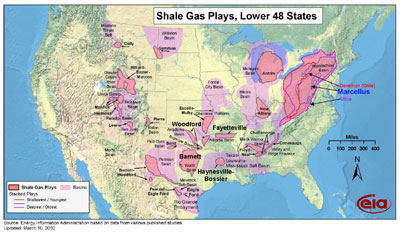Could natural gas fracking fizzle out on its own?
We’ve reported on studies that show that fracking is likely to become a bubble – that the industry has been far over-shooting the amount of natural gas that’s available or that can be extracted cost effectively.
It looks more and more like that’s the case.
Believe it or not, some of the biggest players are putting big swaths of land intended for fracking on sale. Why? Because the deposits are too hard to get to or the huge amount of gas they thought would be there … is not there.
In Ohio, developers that salivated over a potential $500 billion of oil are finding the terrain too difficult to navigate, just like in California. So much for 5.5 billion barrels of recoverable oil …
Last week, the biggest shale landowner, Chesapeake
Energy Corp. put 94,200 acres up for sale in Ohio, and others are doing the same, reports Bloomberg.
The sweet spots for shale seem to be increasingly confined to North Dakota and Texas.
"People started to realize that, you know what, maybe the oil window of the
play is not all it’s cracked up to be," Jonathan Garrett with Wood Mackenzie told Bloomberg, referring to Ohio’s Utica shale formation.
Exploratory drilling shows the Utica shale is much more dense that people expected as well as shallower, making it harder to get oil to flow through the rock, and there’s less natural
pressure to help force it out, Jerry James, president of Artex Oil, explained to Bloomberg.
Another problem is a lack of pipelines to get the oil to market, which would require a $30 billion investment.
Still, some are intent on exploiting the resource and believe it’s a matter of time before technology catches up.
If North America converts largely to natural gas and shale oil for electricity and transportation fuels, the proven reserves could last just 30 years, Mark Zoback, a Stanford University geophysicist said at the Vail Global Energy Forum in March.

Talk About a Bad Investment
Fracking may look good now, but that along with massive investments in expanding oil exploration could have a very different tinge in the near future.
As hard as these industries are trying to hold climate-related regulations back, they are coming … all around the world.
In 2012 alone, the top oil, gas and mining companies spent $674 billion in exploration and development, which means they’re betting they recover that and much more in the future, according to a report by Carbon Tracker.
If this rate of investment continues for the next 10 years, $6 trillion in risks will be wasted on oil that can’t be burned.
60-80% of coal, oil and gas reserves of publicly listed companies are ‘unburnable’ if the world is to have a chance of not exceeding global warming of 2°C, and governments and investors are becoming ever more aware of that.
"Company valuation and credit rating methodologies do not typically inform investors about their exposure to these stranded assets, despite these reserves supporting share value of $4 trillion in 2012 and servicing $1.27 trillion in outstanding corporate debt over the same period," says Carbon Tracker.
Fossil fuel companies could find their bonds being downgraded and equity valuations plummet when industries become less carbon-intensive, says the study.
Even without government action on climate change, falling costs of renewable energy and the increasing urgency of pollution in places like China will drive investors toward low carbon opportunities, the report says.
Read "Unburnable Carbon 2013: Wasted Capital and Stranded Assets":

Something to think about